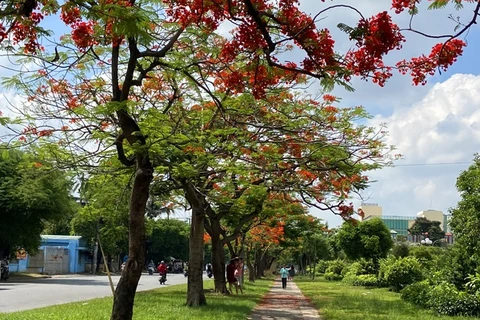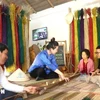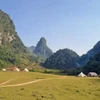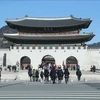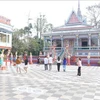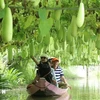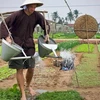 The field of ‘bach nhat’, or globe amaranth, grown in an area of more than 1 ha, is located on Thach Cau street in Long Bien district of Hanoi. It is viewed as the first field of bach nhat in the capital city. The flower, scientifically known as gomphrena globosa, has been a draw to visitor as it is in full bloom. It is an edible plant from the family Amaranthaceae. The round-shaped flower inflorescences are a visually dominant feature and cultivars have been propagated to exhibit shades of magenta, purple, red, orange, white, pink, and lilac. Within the flowerheads, the true flowers are small and inconspicuous. (Photo: VietnamPlus)
The field of ‘bach nhat’, or globe amaranth, grown in an area of more than 1 ha, is located on Thach Cau street in Long Bien district of Hanoi. It is viewed as the first field of bach nhat in the capital city. The flower, scientifically known as gomphrena globosa, has been a draw to visitor as it is in full bloom. It is an edible plant from the family Amaranthaceae. The round-shaped flower inflorescences are a visually dominant feature and cultivars have been propagated to exhibit shades of magenta, purple, red, orange, white, pink, and lilac. Within the flowerheads, the true flowers are small and inconspicuous. (Photo: VietnamPlus)  In Vietnamese language, the flower can be referred to as a type of daisy, namely ‘cuc pha le’ (crystal daisy), cuc nut ao (button daisy). This plant is edible and has been used in herbal medicine. The flowers are rich in betacyanins which have a wide range of applications as additives and supplements in the food, cosmetics, and livestock feed industries. Bach nhat is well suited to be used as natural food dye and have a red-violet colour. As a tropical annual plant, it blooms continuously throughout summer and early fall. It is very heat tolerant and fairly drought resistant, but grows best in full sun and regular moisture. (Photo: VietnamPlus)
In Vietnamese language, the flower can be referred to as a type of daisy, namely ‘cuc pha le’ (crystal daisy), cuc nut ao (button daisy). This plant is edible and has been used in herbal medicine. The flowers are rich in betacyanins which have a wide range of applications as additives and supplements in the food, cosmetics, and livestock feed industries. Bach nhat is well suited to be used as natural food dye and have a red-violet colour. As a tropical annual plant, it blooms continuously throughout summer and early fall. It is very heat tolerant and fairly drought resistant, but grows best in full sun and regular moisture. (Photo: VietnamPlus)  A vast field of pinkish-purple bach nhat in Long Bien district of Hanoi. As a tropical annual plant, it blooms continuously throughout summer and early fall. In Hanoi, autumn is dubbed the season of sunshine. The spring brings in warmth after a biting cold winter, and a scorching summer follows. Then, autumn steps in gracefully, bringing cool, gentle breezes and sunlight that sprinkles just the right amount of warmth all around. The sky shows a brilliant smile. The nice weather creating a suitable temperature in autumn in Hanoi is one of the top choices for visitors to the city during this time. The temperature is from 18 degrees Celsius to 25 degrees Celsius (Photo: VietnamPlus)
A vast field of pinkish-purple bach nhat in Long Bien district of Hanoi. As a tropical annual plant, it blooms continuously throughout summer and early fall. In Hanoi, autumn is dubbed the season of sunshine. The spring brings in warmth after a biting cold winter, and a scorching summer follows. Then, autumn steps in gracefully, bringing cool, gentle breezes and sunlight that sprinkles just the right amount of warmth all around. The sky shows a brilliant smile. The nice weather creating a suitable temperature in autumn in Hanoi is one of the top choices for visitors to the city during this time. The temperature is from 18 degrees Celsius to 25 degrees Celsius (Photo: VietnamPlus)  Many people stand and take photos at the flower field. The plantation of the flower has offered a place for people living in Hanoi to hang out with their families and friends, especially at weekends. Together with famous tourist sites, visitors to Hanoi capital city are always impressed by its different flower seasons and their scents. For example, lotus is a typical feature of the city in the summer. The capital city welcomed 2.92 million visitors, all from localities across the country, in the first ten months of 2021, a fall of 61 percent year on year because of the COVID-19 pandemic, according to the municipal Department of Tourism (Photo: VietnamPlus)
Many people stand and take photos at the flower field. The plantation of the flower has offered a place for people living in Hanoi to hang out with their families and friends, especially at weekends. Together with famous tourist sites, visitors to Hanoi capital city are always impressed by its different flower seasons and their scents. For example, lotus is a typical feature of the city in the summer. The capital city welcomed 2.92 million visitors, all from localities across the country, in the first ten months of 2021, a fall of 61 percent year on year because of the COVID-19 pandemic, according to the municipal Department of Tourism (Photo: VietnamPlus)  A piano along with decorations placed at the field of "bach nhat" makes the scenery become more picturesque and romantic. The plant is about 30-60 cm in height. As a tropical annual plant, "bach nhat" blooms continuously throughout summer and early fall. It is very heat tolerant and fairly drought resistant, but grows best in full sun and regular moisture. The plant is from the family Amaranthaceae, or flowering plants commonly known as the amaranth family. The round-shaped flower inflorescences are a visually dominant feature and cultivars have been propagated to exhibit shades of magenta, purple, red, orange, white, pink, and lilac (Photo: VietnamPlus)
A piano along with decorations placed at the field of "bach nhat" makes the scenery become more picturesque and romantic. The plant is about 30-60 cm in height. As a tropical annual plant, "bach nhat" blooms continuously throughout summer and early fall. It is very heat tolerant and fairly drought resistant, but grows best in full sun and regular moisture. The plant is from the family Amaranthaceae, or flowering plants commonly known as the amaranth family. The round-shaped flower inflorescences are a visually dominant feature and cultivars have been propagated to exhibit shades of magenta, purple, red, orange, white, pink, and lilac (Photo: VietnamPlus)  Visitors pose in the pinkish purple flower field with a small wooden house in the background. The plant has oval leaves with pointy ends, which stick close to the stem. Facing complex developments of the COVID-19 pandemic both domestically and abroad, many tourism firms have sketched an array of measures to overcome difficulties and maintain their business. Although some tourist sites are allowed to open as long as preventive measures strictly followed, Hanoi has been asked to prepare standard procedures for home quarantine and treatment in case the coronavirus spreads on a large scale. Hanoi had administered 9,664,917 doses of COVID-19 vaccine to local residents as of early November. (Photo: VietnamPlus)
Visitors pose in the pinkish purple flower field with a small wooden house in the background. The plant has oval leaves with pointy ends, which stick close to the stem. Facing complex developments of the COVID-19 pandemic both domestically and abroad, many tourism firms have sketched an array of measures to overcome difficulties and maintain their business. Although some tourist sites are allowed to open as long as preventive measures strictly followed, Hanoi has been asked to prepare standard procedures for home quarantine and treatment in case the coronavirus spreads on a large scale. Hanoi had administered 9,664,917 doses of COVID-19 vaccine to local residents as of early November. (Photo: VietnamPlus)  Two female visitors pose at the "bach nhat" field. The field, home to about 130,000 plants, is located on Thach Cau street in Long Bien district. The high density of flowers offers various angles for visitors to take photos. It takes four months for the seed to grow and form flowers, which will last for around three months. The owner of the field also made efforts to avoid overloading in the context of COVID-19. It is worthy of note that the colour of the flower will not fade and its petals will not fall off like those of others. Therefore, it is among plants suitable for making dried flowers (Photo: VietnamPlus)
Two female visitors pose at the "bach nhat" field. The field, home to about 130,000 plants, is located on Thach Cau street in Long Bien district. The high density of flowers offers various angles for visitors to take photos. It takes four months for the seed to grow and form flowers, which will last for around three months. The owner of the field also made efforts to avoid overloading in the context of COVID-19. It is worthy of note that the colour of the flower will not fade and its petals will not fall off like those of others. Therefore, it is among plants suitable for making dried flowers (Photo: VietnamPlus)  A woman poses at the globe amaranth field. The flowers are among plants suitable for making dried flowers. Hanoi had administered more than 9.66 million doses of COVID-19 vaccine to local residents as of early November. About 92.3 percent of the people aged 18 and above have been given at least one shot, accounting for 69.4 percent of its total population. The COVID-19 pandemic in Hanoi is currently under control, but the virus transmission from localities with complex pandemic developments remains a risk. As a result, local people opt for going to spacious places with charming landscapes to take wonderful photos and selfies (Photo: VietnamPlus)
A woman poses at the globe amaranth field. The flowers are among plants suitable for making dried flowers. Hanoi had administered more than 9.66 million doses of COVID-19 vaccine to local residents as of early November. About 92.3 percent of the people aged 18 and above have been given at least one shot, accounting for 69.4 percent of its total population. The COVID-19 pandemic in Hanoi is currently under control, but the virus transmission from localities with complex pandemic developments remains a risk. As a result, local people opt for going to spacious places with charming landscapes to take wonderful photos and selfies (Photo: VietnamPlus)  Two female friends pose for a photo amid the field of globe amaranth. People’s first impression on the flowers are about dreamy and romantic shade of purple. They may feel like they have entered a wonderland in fairy tales because of the immensity and beauty of the place. The owner of the field said the flowers were only in shades of red and white before. A new variety was created just two years ago and the purple-coloured field built. As a tropical annual plant, globe amaranth blooms continuously throughout summer and early fall. It is very heat tolerant and fairly drought resistant, but grows best in full sun and regular moisture (Photo: VietnamPlus)
Two female friends pose for a photo amid the field of globe amaranth. People’s first impression on the flowers are about dreamy and romantic shade of purple. They may feel like they have entered a wonderland in fairy tales because of the immensity and beauty of the place. The owner of the field said the flowers were only in shades of red and white before. A new variety was created just two years ago and the purple-coloured field built. As a tropical annual plant, globe amaranth blooms continuously throughout summer and early fall. It is very heat tolerant and fairly drought resistant, but grows best in full sun and regular moisture (Photo: VietnamPlus)  Visitors happily pose for photos while sitting amid the flower field, which will be more crowded at weekends. It will be opened to visitors from 6 am to 7 pm everyday and a ticket is 70,000 VND (3 USD). With new horticulture techniques, besides the original colours of red and white, bach nhat now can be in the hues of pink, magenta and lilac. This plant is edible and has been used in herbal medicine. The flowers are rich in betacyanins which have a wide range of applications as additives and supplements in the food, cosmetics, and livestock feed industries. Globe amaranth is well suited to be used as natural food dye (Photo: VietnamPlus)
Visitors happily pose for photos while sitting amid the flower field, which will be more crowded at weekends. It will be opened to visitors from 6 am to 7 pm everyday and a ticket is 70,000 VND (3 USD). With new horticulture techniques, besides the original colours of red and white, bach nhat now can be in the hues of pink, magenta and lilac. This plant is edible and has been used in herbal medicine. The flowers are rich in betacyanins which have a wide range of applications as additives and supplements in the food, cosmetics, and livestock feed industries. Globe amaranth is well suited to be used as natural food dye (Photo: VietnamPlus)  As dressing up nicely for taking impressive and lovely photos has become more popular among Vietnamese people, the field has welcomed an increasing number of visitors, especially youngsters and families. Hanoi capital city greeted 2.92 million visitors, all from provinces and cities across the country, in the first ten months of 2021, a fall of 61 percent year on year because of the COVID-19 pandemic, according to the municipal Department of Tourism. A safe tour with a combination of automatic audio guides and traditional sightseeing has been launched at the Vietnam National Museum of History. The event was organised by the museum in collaboration with the Hanoitourist Corporation (Hanoitourist) to adapt to the current COVID-19 pandemic and adjust the museum's operations in the new normal (Photo: VietnamPlus)
As dressing up nicely for taking impressive and lovely photos has become more popular among Vietnamese people, the field has welcomed an increasing number of visitors, especially youngsters and families. Hanoi capital city greeted 2.92 million visitors, all from provinces and cities across the country, in the first ten months of 2021, a fall of 61 percent year on year because of the COVID-19 pandemic, according to the municipal Department of Tourism. A safe tour with a combination of automatic audio guides and traditional sightseeing has been launched at the Vietnam National Museum of History. The event was organised by the museum in collaboration with the Hanoitourist Corporation (Hanoitourist) to adapt to the current COVID-19 pandemic and adjust the museum's operations in the new normal (Photo: VietnamPlus)  A girl stands amid the flower field. Many people in the capital city, including young people and flower lovers, come to enjoy the pinkish purple field of globe amaranth, which they referred to as a wonderland because of its romantic scenery. In Vietnamese language, the flower can be referred to as a type of daisy, namely ‘cuc pha le’ (crystal daisy), cuc nut ao (button daisy). This plant is edible and has been used in herbal medicine. The flowers are rich in betacyanins which have a wide range of applications as additives and supplements in the food, cosmetics, and livestock feed industries (Photo: VietnamPlus)
A girl stands amid the flower field. Many people in the capital city, including young people and flower lovers, come to enjoy the pinkish purple field of globe amaranth, which they referred to as a wonderland because of its romantic scenery. In Vietnamese language, the flower can be referred to as a type of daisy, namely ‘cuc pha le’ (crystal daisy), cuc nut ao (button daisy). This plant is edible and has been used in herbal medicine. The flowers are rich in betacyanins which have a wide range of applications as additives and supplements in the food, cosmetics, and livestock feed industries (Photo: VietnamPlus)  Young people pose at the field of globe amaranth. People’s first impression on the flowers are about dreamy and romantic shade of purple. They may feel like they have entered a wonderland in fairy tales because of the immensity and beauty of the place. The owner of the field said the flowers were only in shades of red and white before. A new variety was created just two years ago and the purple-coloured field built. As a tropical annual plant, globe amaranth blooms continuously throughout summer and early fall. The round-shaped flower inflorescences are a visually dominant feature and cultivars have been propagated to exhibit shades of magenta, purple, red, orange, white, pink, and lilac (Photo: VietnamPlus)
Young people pose at the field of globe amaranth. People’s first impression on the flowers are about dreamy and romantic shade of purple. They may feel like they have entered a wonderland in fairy tales because of the immensity and beauty of the place. The owner of the field said the flowers were only in shades of red and white before. A new variety was created just two years ago and the purple-coloured field built. As a tropical annual plant, globe amaranth blooms continuously throughout summer and early fall. The round-shaped flower inflorescences are a visually dominant feature and cultivars have been propagated to exhibit shades of magenta, purple, red, orange, white, pink, and lilac (Photo: VietnamPlus)  As this is the first time such a field of globe amaranth is built in Hanoi, young people are enthralled with the scenery. The field, covering an area of more than 1 ha, is located on Thach Cau street in Long Bien district of the capital city. Long Bien was incorporated as an urban district in 2003 from the north western portion of Gia Lam district adjacent to the city centre. It is Hanoi's only urban district on the east side of the Red River. The district includes Long Bien Bridge, the headquarters of national flag carrier Vietnam Airlines, the Civil Aviation Authority of Vietnam (CAAV), and Vingroup (Photo: VietnamPlus)
As this is the first time such a field of globe amaranth is built in Hanoi, young people are enthralled with the scenery. The field, covering an area of more than 1 ha, is located on Thach Cau street in Long Bien district of the capital city. Long Bien was incorporated as an urban district in 2003 from the north western portion of Gia Lam district adjacent to the city centre. It is Hanoi's only urban district on the east side of the Red River. The district includes Long Bien Bridge, the headquarters of national flag carrier Vietnam Airlines, the Civil Aviation Authority of Vietnam (CAAV), and Vingroup (Photo: VietnamPlus)  A young woman poses amid the pinkish purple flowers in full bloom. The field attracts many young people in Hanoi over the recent weeks. The plant is about 30-60 cm in height. As a tropical annual plant, bach nhat blooms continuously throughout summer and early fall. It is very heat tolerant and fairly drought resistant, but grows best in full sun and regular moisture. The plant is from the family Amaranthaceae, or flowering plants commonly known as the amaranth family. The field is home to about 130,000 plants. The high density of flowers offers various angles for visitors to take photos. It takes four months for the seed to grow and form flowers, which will last for around three months (Photo: VietnamPlus)
A young woman poses amid the pinkish purple flowers in full bloom. The field attracts many young people in Hanoi over the recent weeks. The plant is about 30-60 cm in height. As a tropical annual plant, bach nhat blooms continuously throughout summer and early fall. It is very heat tolerant and fairly drought resistant, but grows best in full sun and regular moisture. The plant is from the family Amaranthaceae, or flowering plants commonly known as the amaranth family. The field is home to about 130,000 plants. The high density of flowers offers various angles for visitors to take photos. It takes four months for the seed to grow and form flowers, which will last for around three months (Photo: VietnamPlus)  A young woman poses amid the pinkish purple flowers in full bloom. Globe amaranth is a tropical annual that features long-lasting, globe-shaped blossoms in a variety of colors. Ideal for beds, borders, and rock gardens, plants are drought tolerant and suitable for xeriscapes. It’s native to Central and northern South America, where its classic magenta blossoms dot the landscape. The bright flower heads resemble clover, with tubular bracts instead of petals. They are stiff and papery like those of strawflowers. Each bract contains a tiny white or yellow flower that is visible at close range. Thanks to the magic of hybridization, flowers are available in an array of vivid shades, including lilac, magenta, pink, purple, red, orange, and white (Photo: VietnamPlus)
A young woman poses amid the pinkish purple flowers in full bloom. Globe amaranth is a tropical annual that features long-lasting, globe-shaped blossoms in a variety of colors. Ideal for beds, borders, and rock gardens, plants are drought tolerant and suitable for xeriscapes. It’s native to Central and northern South America, where its classic magenta blossoms dot the landscape. The bright flower heads resemble clover, with tubular bracts instead of petals. They are stiff and papery like those of strawflowers. Each bract contains a tiny white or yellow flower that is visible at close range. Thanks to the magic of hybridization, flowers are available in an array of vivid shades, including lilac, magenta, pink, purple, red, orange, and white (Photo: VietnamPlus)  A young woman poses amid the pinkish purple flowers in full bloom. Tropical by nature, globe amaranth, aka gomphrena, has a high tolerance for heat and humidity, and craves sunshine. With its long taproot it has above average drought tolerance, but prefers consistent moisture, especially during the germination and seedling stages. When it comes to soil, it can thrive in anything from loam to clay, provided the drainage is excellent. This is a plant with an upright growth habit that tends to get leggy unless you pinch some flowers early in the growing season. The flower, scientifically known as gomphrena globosa, has been a draw to visitor as it is in full bloom (Photo: VietnamPlus)
A young woman poses amid the pinkish purple flowers in full bloom. Tropical by nature, globe amaranth, aka gomphrena, has a high tolerance for heat and humidity, and craves sunshine. With its long taproot it has above average drought tolerance, but prefers consistent moisture, especially during the germination and seedling stages. When it comes to soil, it can thrive in anything from loam to clay, provided the drainage is excellent. This is a plant with an upright growth habit that tends to get leggy unless you pinch some flowers early in the growing season. The flower, scientifically known as gomphrena globosa, has been a draw to visitor as it is in full bloom (Photo: VietnamPlus)  The flower field in Hanoi draws crowds of visitors, especially youngsters. The flowers are attractive to butterflies and are often dried and preserved for crafts and flower arrangements. The minute flowers lack true petals but have red, pink, purple, orange, or white bracts. The leaves are simple with entire margins and are arranged oppositely along the reddish stems. A prolific bloomer, the plant continually produces dense round flower clusters on long stalks throughout the summer and fall. The globe amaranth (Gomphrena) has brightly coloured bracts which can be dried without losing its vibrancy. These cheery, long-lasting flowers symbolise unfading love and respect (Photo: VietnamPlus)
The flower field in Hanoi draws crowds of visitors, especially youngsters. The flowers are attractive to butterflies and are often dried and preserved for crafts and flower arrangements. The minute flowers lack true petals but have red, pink, purple, orange, or white bracts. The leaves are simple with entire margins and are arranged oppositely along the reddish stems. A prolific bloomer, the plant continually produces dense round flower clusters on long stalks throughout the summer and fall. The globe amaranth (Gomphrena) has brightly coloured bracts which can be dried without losing its vibrancy. These cheery, long-lasting flowers symbolise unfading love and respect (Photo: VietnamPlus)  The flower field in Hanoi draws crowds of visitors, especially youngsters. Hanoi has great potential for developing flower tourism. It is time for the city to pay attention to comprehensively investing in flower tourism and make it a specialty of the city and a special tourist product, helping to increase income for farmers and attract tourists to the capital. When the flower season comes, Hanoi puts on a new shirt. In addition to the traditional flower craft villages, in recent years, the suburbs of Hanoi have also developed strongly the profession of growing flowers and ornamental plants, forming specialised intensive production areas. This is a key condition for developing flower-eco tours (Photo: VietnamPlus)
The flower field in Hanoi draws crowds of visitors, especially youngsters. Hanoi has great potential for developing flower tourism. It is time for the city to pay attention to comprehensively investing in flower tourism and make it a specialty of the city and a special tourist product, helping to increase income for farmers and attract tourists to the capital. When the flower season comes, Hanoi puts on a new shirt. In addition to the traditional flower craft villages, in recent years, the suburbs of Hanoi have also developed strongly the profession of growing flowers and ornamental plants, forming specialised intensive production areas. This is a key condition for developing flower-eco tours (Photo: VietnamPlus)  Visitors pose for photos at the flower field in Hanoi. Globe amaranth is on the list of florists' favorite dried flowers, with its papery pink and purple blooms. Gomphrena also is a valuable low-growing front-of-the-border flower, performing throughout the summer season. Pinch back spent blossoms to encourage rounded clumps of foliage to develop. With stiff, papery blooms, globe amaranth is a long-lasting cut flower as well as a dependable flowering annual for the front of the border. Gomphrena typically has bright purple or pink flower bracts (although white, orange, and yellow cultivars are available) and will make excellent dried flower bouquets (Photo: VietnamPlus)
Visitors pose for photos at the flower field in Hanoi. Globe amaranth is on the list of florists' favorite dried flowers, with its papery pink and purple blooms. Gomphrena also is a valuable low-growing front-of-the-border flower, performing throughout the summer season. Pinch back spent blossoms to encourage rounded clumps of foliage to develop. With stiff, papery blooms, globe amaranth is a long-lasting cut flower as well as a dependable flowering annual for the front of the border. Gomphrena typically has bright purple or pink flower bracts (although white, orange, and yellow cultivars are available) and will make excellent dried flower bouquets (Photo: VietnamPlus)  A kid plays in the globe amaranth field in Hanoi. Not only famous for its beautiful landscapes, Hanoi is also blessed with the typical flower seasons that make visitors fall in love. Every time when flower season comes, Hanoi puts on a new shirt. Mentioning about flowers in Hanoi, it is also about the traditional flower villages that become inspiration for poetry, such as Ngoc Ha, Nghi Tam, Nhat Tan and Quang Ba. Every year when Lunar New Year Festival arrives, Hanoi opens the Spring flower markets which are also considered as an attractive tourism resource of Hanoi. This is a key condition for developing flower-eco tours (Photo: VietnamPlus)
A kid plays in the globe amaranth field in Hanoi. Not only famous for its beautiful landscapes, Hanoi is also blessed with the typical flower seasons that make visitors fall in love. Every time when flower season comes, Hanoi puts on a new shirt. Mentioning about flowers in Hanoi, it is also about the traditional flower villages that become inspiration for poetry, such as Ngoc Ha, Nghi Tam, Nhat Tan and Quang Ba. Every year when Lunar New Year Festival arrives, Hanoi opens the Spring flower markets which are also considered as an attractive tourism resource of Hanoi. This is a key condition for developing flower-eco tours (Photo: VietnamPlus)  The flower field is also an ideal destination for couples to take wedding photos. In addition to the traditional flower craft villages, in recent years, the suburbs of Hanoi have also developed strongly the profession of growing flowers and ornamental plants, forming specialised intensive production areas. Despite the great potential for tourism, in fact, Hanoi has yet exploited this “gold mine” effectively. Some tours to the flower villages are mostly for sightseeing and are offered spontaneously by some households. Moreover, trade and tourism promotion for this type of product has not properly received attention. The potential for developing flower tourism in Hanoi is very large but to turn flowers into a unique tourism product, Hanoi has still a long way to go (Photo: VietnamPlus)
The flower field is also an ideal destination for couples to take wedding photos. In addition to the traditional flower craft villages, in recent years, the suburbs of Hanoi have also developed strongly the profession of growing flowers and ornamental plants, forming specialised intensive production areas. Despite the great potential for tourism, in fact, Hanoi has yet exploited this “gold mine” effectively. Some tours to the flower villages are mostly for sightseeing and are offered spontaneously by some households. Moreover, trade and tourism promotion for this type of product has not properly received attention. The potential for developing flower tourism in Hanoi is very large but to turn flowers into a unique tourism product, Hanoi has still a long way to go (Photo: VietnamPlus)  The field of globe amaranth is blooming in Thach Cau (Long Bien, Hanoi), like purple covering a corner of the sky, making many young people and flower lovers come to enjoy and take pictures. In the last days of November, young people in Hanoi spread their words about the field that is “beautiful like Europe”. This fancy, purple garden is over 10,000 square meters with about 130,000 cypress trees, located in a film studio in Thach Cau area, Long Bien, Hanoi. At the weekend, dozens of groups of tourists come here to admire and take pictures. The eye-catching and impressive colors make many people think of the fields in France and Italy (Photo: VietnamPlus)
The field of globe amaranth is blooming in Thach Cau (Long Bien, Hanoi), like purple covering a corner of the sky, making many young people and flower lovers come to enjoy and take pictures. In the last days of November, young people in Hanoi spread their words about the field that is “beautiful like Europe”. This fancy, purple garden is over 10,000 square meters with about 130,000 cypress trees, located in a film studio in Thach Cau area, Long Bien, Hanoi. At the weekend, dozens of groups of tourists come here to admire and take pictures. The eye-catching and impressive colors make many people think of the fields in France and Italy (Photo: VietnamPlus)  The globe amaranth (Gomphrena) has brightly coloured bracts which can be dried without losing its vibrancy. These cheery, long-lasting flowers symbolise unfading love and respect. This plant is edible and has been used in herbal medicine. The flowers are rich in betacyanins which have a wide range of applications as additives and supplements in the food, cosmetics, and livestock feed industries. The flower is well suited to be used as natural food dye and have a red-violet colour. As a tropical annual plant, it blooms continuously throughout summer and early fall. It is very heat tolerant and fairly drought resistant, but grows best in full sun and regular moisture (Photo: VietnamPlus)
The globe amaranth (Gomphrena) has brightly coloured bracts which can be dried without losing its vibrancy. These cheery, long-lasting flowers symbolise unfading love and respect. This plant is edible and has been used in herbal medicine. The flowers are rich in betacyanins which have a wide range of applications as additives and supplements in the food, cosmetics, and livestock feed industries. The flower is well suited to be used as natural food dye and have a red-violet colour. As a tropical annual plant, it blooms continuously throughout summer and early fall. It is very heat tolerant and fairly drought resistant, but grows best in full sun and regular moisture (Photo: VietnamPlus)  Visitors to the flower field pose for a photo. Globe amaranth is a tropical annual that features long-lasting, globe-shaped blossoms in a variety of colors. Ideal for beds, borders, and rock gardens, plants are drought tolerant and suitable for xeriscapes. It’s native to Central and South America, where its classic magenta blossoms dot the landscape. Related plants include love lies bleeding amaranth, cockscomb, and spinach. The bright flower heads resemble clover, with tubular bracts instead of petals. They are stiff and papery like those of strawflowers. Each bract contains a tiny white or yellow flower that is visible at close range. Thanks to the magic of hybridization, flowers are available in an array of vivid shades, including lilac, magenta, pink, purple, red, orange, and white (Photo: VietnamPlus)
Visitors to the flower field pose for a photo. Globe amaranth is a tropical annual that features long-lasting, globe-shaped blossoms in a variety of colors. Ideal for beds, borders, and rock gardens, plants are drought tolerant and suitable for xeriscapes. It’s native to Central and South America, where its classic magenta blossoms dot the landscape. Related plants include love lies bleeding amaranth, cockscomb, and spinach. The bright flower heads resemble clover, with tubular bracts instead of petals. They are stiff and papery like those of strawflowers. Each bract contains a tiny white or yellow flower that is visible at close range. Thanks to the magic of hybridization, flowers are available in an array of vivid shades, including lilac, magenta, pink, purple, red, orange, and white (Photo: VietnamPlus)  On those days, visitors, particularly young people, have flocked to the flower field. This fancy, purple garden is over 10,000 square meters with about 130,000 cypress plants, located in a film studio in Thach Cau ward of Long Bien district of Hanoi. At the weekend, dozens of groups of tourists come here to admire and take pictures. The eye-catching and impressive colors make many people think of the fields in France or Italy. On the beautiful purple flower background, girls enjoy posing for photos. The blooming flower garden not only attracts young people but also is a favorite destination for many families and photography lovers (Photo: VietnamPlus)
On those days, visitors, particularly young people, have flocked to the flower field. This fancy, purple garden is over 10,000 square meters with about 130,000 cypress plants, located in a film studio in Thach Cau ward of Long Bien district of Hanoi. At the weekend, dozens of groups of tourists come here to admire and take pictures. The eye-catching and impressive colors make many people think of the fields in France or Italy. On the beautiful purple flower background, girls enjoy posing for photos. The blooming flower garden not only attracts young people but also is a favorite destination for many families and photography lovers (Photo: VietnamPlus)  Many couples choose this flower garden as a place to take wedding photos. The space covered with purple faithfully creates a poetic and romantic feeling. It is known that it takes four months to form the flower garden. Flowers will bloom in about three months and then fade. Due to the epidemic, visitors to the garden taking photos must comply with the 5K regulations and scan the QR code. At the garden, visitors are reminded to wear masks regularly, and not to congregate in one area. During the photo-taking process, visitors can take off their masks temporarily as long as they keep a standard distance from others (Photo: VietnamPlus)
Many couples choose this flower garden as a place to take wedding photos. The space covered with purple faithfully creates a poetic and romantic feeling. It is known that it takes four months to form the flower garden. Flowers will bloom in about three months and then fade. Due to the epidemic, visitors to the garden taking photos must comply with the 5K regulations and scan the QR code. At the garden, visitors are reminded to wear masks regularly, and not to congregate in one area. During the photo-taking process, visitors can take off their masks temporarily as long as they keep a standard distance from others (Photo: VietnamPlus) VNA
